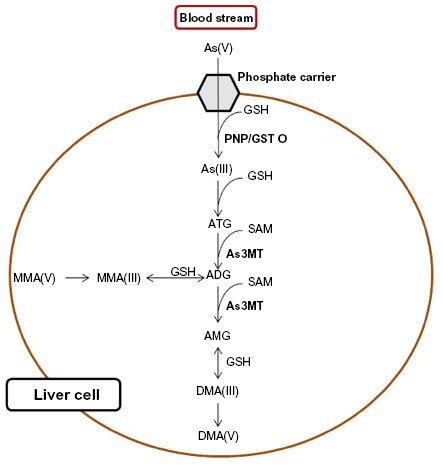Latest news: Cancer progression as an effect of low level arsenic exposure linked to epigenetic regulations of cancer suppressive genes.
200 million people worldwide is being exposed to hazardous arsenic levels, causing severe health effects and often cancer in liver,skin or the kidneys. Scientists have long wondered what mechanisms that actually cause cancer as a response to long time, low level, arsenic exposure. There are plenty of possible biochemical pathways and mechanisms behind arsenic induced cancer progression but technical progress in the later years have made led to clear correlations between epigenetic regulation and cancer. Epigenetic regulations is the body's way to change its genetic expression depending on the environment.
Certain cancer types have long been treated with arsenic oxides knowing that it leads to changes in the methylation patterns of histones and thereby the structure of the chromatin. This will regulate the expression of certain genes by making them more or less accessible to transcriptase, enzymes responsible for starting the gene expression. After treatment with arsenic oxide levels of cancer suppressive proteins have been see, curing or slowing down the cancer. In cancer cells arsenic can´t cause any damage since it really can't get worse for the cell, but in healthy cells it causes regulations directly linked to cancer progression, according to the scientist behind the rewive.
A new study recently used blood samples from patients chronically exposed to arsenic, with skin cancer patients with no knows exposure to arsenic, Methylation patterns were studied, a direct way to regulate gene expressions, and large deviations were found. Two genes reported downreglated in this study is P53&P16 two important cancer suppressive proteins, responsible for e.g apoptosis, meaning death for a cell when something goes wrong. P53 was the biggest deviation pointing to its relevance in cancer progression. Both these genes are rich in so called CpG regions proving its involvement in the deviations.
In total 3000 changed methylation patterns were found, and most of the around CpG regions pointing to DNMT1´s involvement, an large protein important for cell division amongst other things. DNMT1 uses SAM, S-adenosylmethionine as donor group for methylations. Inorganic arsenic is methylated in the body, leading to low SAM levels. When levels go low, more of it is produced in the liver and is transported via the bloodstream. The study shows that the blood is prone to hypermethylation meaning ”over methylation” as a response to low methyl levels, which might have been confusing prior to these insights.

A less well studied aspect of SAM is that it can inhibit enzymes at higher concentrations, giving certain enzymes a window of high activity as SAM is being depleted, further proving its involvement in the hypermethylation of important genes.When the human body is exposed to arsenic over long periods, methyl arsenate is produced along with dimethyl arsenate furthering the global SAM depletion.
These effects are creating instability in the genome and cells will not be able to recruit cancer suppressive proteins as usual. With insights in methylation patterns and especially the involvement of CPG regions, larger studies on cancer related genes and their methylation patterns can be executed with good precision, leading to methods for treatment.
To clear things upp, i am the scnientist behind the work.
All of my posts are 100% original work done by me and me alone.